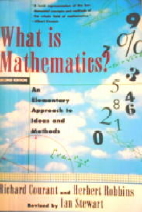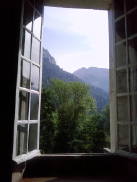I thought recently, again, about the relationship between the written word and mathematical notation, both being systems of marks that carry meaning. Both systems grow with usage, and both provide some steady refinement of what we are able to see. I’m not so much interested, here, in the relationship between mathematical proficiency and language proficiency, but more what cognitive processes they share that construct meaning and, more importantly, what might be their shared purposes. What can we say, for example, about the value of a good novel.
In a discussion of Michael Schmidt’s The Novel: A Biography which William Deresiewicz calls, How the Novel Made the Modern World, Deresiewicz makes the following remark:
The novel reaches in and out at once. Like no other art, not poetry or music on the one hand, not photography or movies on the other, it joins the self to the world, puts the self in the world, does the deep dive of interiority and surveils the social scope. That polarity, that tension…has proved endlessly generative.
The keys here are ‘reaching in and out at once,’ ‘joining the self to the world’ within a process endlessly ‘generative’ – generative of consistently changing views of ourselves, of the ways we organize ourselves, and of the possibilities our imagination can offer. The novel makes something new of familiar experience through the skillful arrangement of abstract, discrete and symbolic units of sound. The novel is not identified with these arrangements, but it completely relies on them.
Steven Pinker investigates the relationship between language and thought, and has described the conceptual schemes that are generalized with language. In a TED talk he gave in 2005, before the publication of The Stuff of Thought in 2007, Pinker argues that our use of language
seems to be based on a fixed set of concepts, which govern dozens of constructions and thousands of verbs — not only in English, but in all other languages — fundamental concepts such as space, time, causation and human intention, such as, what is the means and what is the ends? These are reminiscent of the kinds of categories that Immanuel Kant argued are the basic framework for human thought, and it’s interesting that our unconscious use of language seems to reflect these Kantian categories.
Shared constructions don’t care about perceptual qualities, such as color, texture, weight and speed, which virtually never differentiate the use of verbs in different constructions. This kind of generalization, Pinker says is:
a process of metaphorical abstraction that allows us to bleach these concepts of their original conceptual content — space, time and force — and apply them to new abstract domains, therefore allowing a species that evolved to deal with rocks and tools and animals, to conceptualize mathematics, physics, law and other abstract domains.
This characterization of what language does is essentially the argument in the Lakoff/Núñez book, Where Mathematics Comes From. But mathematics, like language, finds relationships within frameworks of thought that open the door to new thought. In mathematics, this happens by digging deeper into the how the mind creates any kind of structure – from the patterns in visual data, to the less understood integration of multi-modal experience.
In a 2009 publication, (Geometrein: Measuring the Environment as a Means of Orientation, in Ruedi Bauer, Andrea Gleiniger (eds.): Orientierung – Disorientierung, Lars Müller Publishing, p.282-290) Toni Kotnik makes the following observations of mathematics within a discussion of architecture and its relationship to the body orienting itself:
The limits of Euclidean geometry illustrate that the act of orientation, as an active measurement of surrounding space, determines a structure that is both geometric and metric in nature. Both structures can be understood as cognitive structures of knowledge generated by perception and experience – structures that, as individual patterns of action, shape the individual perception of the world…and, conversely, impinge on perception.
Kotnik then discusses Riemann’s famous lecture, “On the Hypotheses Which Lie at the basis of Geometry,” making the point that these ideas were strongly influenced by the work of philosopher Johan Friedrich Herbart.
According to Herbart, as people move through space, they have a variety of perceptions that do not have an immediate effect on consciousness. Herbart argues that these perceptions undergo a “graded fusion” in the mind… Riemann’s idea of manifolds renders Herbart’s psychological concepts more concrete and precise for mathematical application.
In his conclusion:
Euclid’s geometry and its universalized form in Riemann’s manifolds are examples of how mathematical concepts can be created by formalizing the act of orientation.
Here, again, mathematics is understood as the formalization of the body’s action. Lets look at words again. In a recent post I discussed Peter Mendelsund’s book What We See When We Read. This takes us back to the novel. In that post, I reproduced this of Mendelsund’s:
The world, as we read it, is made of fragments. Discontinuous points – discrete and dispersed.
(So are we. So too our coworkers; spouses; parents; children; friends..)
We know ourselves and those around us by our reading of them, by the epithets we have given them, by their metaphors, synechdoches, metonymies. Even those we love most in the world. We read them in their fragments and substitutions.
The world for us is a work in progress. And what we understand of it we understand by cobbling these pieces together – synthesizing them over time.
It is the synthesis that we know. (It is all we know.)
And all the while we are committed to believing in the totality – the fiction of seeing.
…Authors are curators of experience.
…reading mirrors the procedure by which we acquaint ourselves with the world. It is not that our narratives necessarily tell us something true about the world (though they might), but rather that the practice of reading feels like, and is like, consciousness itself; imperfect; partial; hazy; co-creative.
Writers reduce when they write, and readers reduce when they read. The brain itself is built to reduce, replace, emblemize…Verisimilitude is not only a false idol, but also an unattainable goal. So we reduce. And it is not without reverence that we reduce. This is how we apprehend the world. This is what humans do.
Picturing stories is making reductions. Through reductions, we create meaning.
Here the world itself is a work in progress, of synthesized discrete fragments, and reading mirrors the way we acquaint ourselves with the world.
I’ve been part of discussions among computer scientists and cognitive scientists where the question arises, to what extent is mathematics its formal representation? Modeling mathematical relationships in both digital and analog forms suggests that the formal representation of mathematics is not, in itself, actually the mathematics. I think these are useful questions. But I will continue to argue that the meaning brought about by the discovery of mathematical structure relies on the infinite potential of notation in the same way that the meaning in story relies on the infinite potential of word constructions . Mathematics is only more abstract to the extent that in doing mathematics, one is driven to explore the depths of cognitive structures themselves, without reference to our experience. But it is the application of this exploration that has fine-tuned sensation, and brought greater depth to what we can know about our being in the world.


Recent Comments